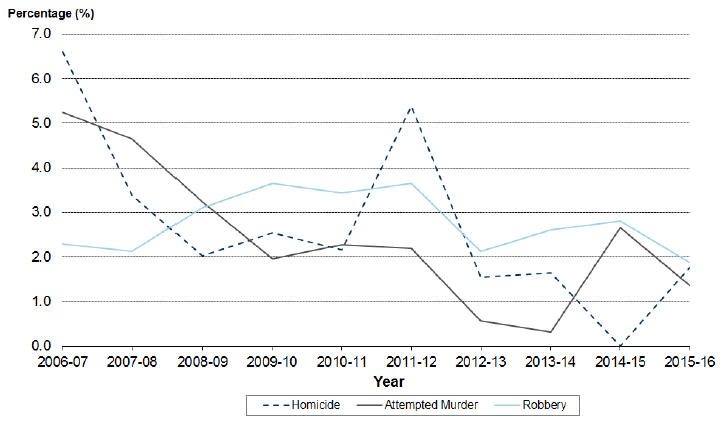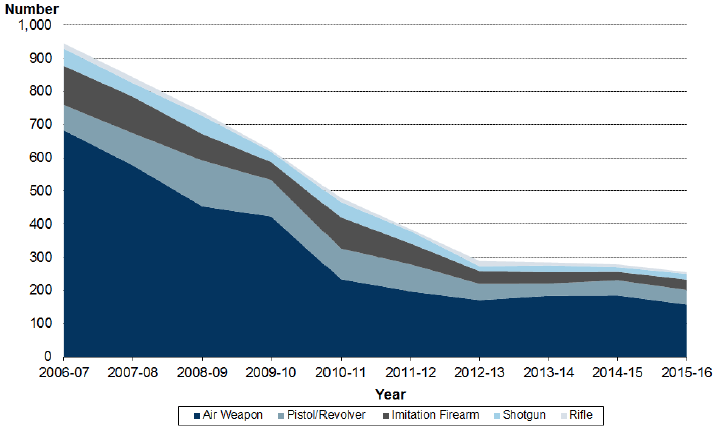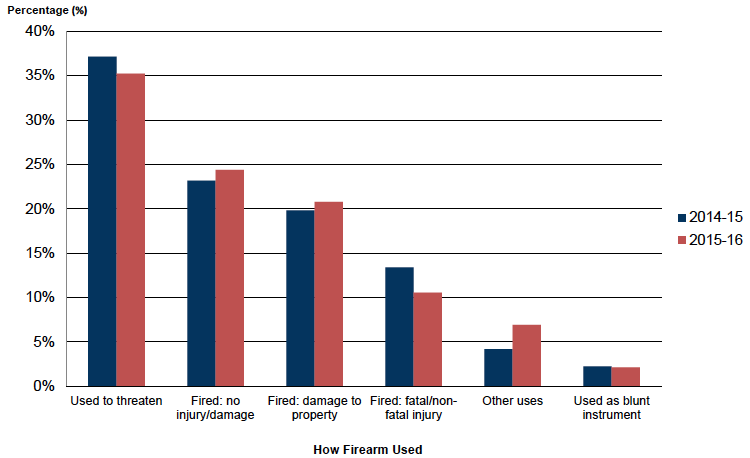Recorded Crimes and Offences Involving Firearms, Scotland, 2014-2015 and 2015-2016
Statistics on those crimes and offences recorded by the police in Scotland in which a firearm was alleged to have been involved or where a firearm was stolen.
This document is part of a collection
3. Commentary
3.1 Offences involving firearms (Tables 1, 2, 2a, 3 and 4, and Charts 1 and 2)
- In 2014-15, Scottish police forces recorded 358 offences in which a firearm was alleged to have been involved, a decrease of 5% since 2013-14. In 2015-16, the police recorded 332 offences, a decrease of 7% from 2014-15. This is the lowest recorded total since comparable records began, and a decrease of 71% since 2006-07
- The offence category which contained the highest number of offences involving a firearm in 2015-16 was Breach of the peace etc., accounting for 18% of all recorded offences involving a firearm. This was closely followed by the Common assault and Reckless conduct with firearms offence categories, both of which constituted a further 18% each of offences involving a firearm in 2015-16.
- In 2014-15 no Homicides involving a firearm were recorded, while one was recorded in 2015-16. There were seven Attempted murders involving a firearm in 2014-15 and four in 2015-16.
- The number of Serious assaults involving a firearm increased by two offences from two in 2014-15 to four in 2015-16. In 2015-16 there were 25 Robberies involving a firearm, decreasing from 42 in 2014-15. The number of robberies involving a firearm were at their lowest level in the past ten-years.
- When air weapons and unidentified weapons are excluded, the total number of offences involving a firearm increased by 5% between 2014-15 and 2015-16 (from 144 offences to 151 offences).
- Offences relating to Common assault account for the largest proportion of offences involving a firearm (21%) when air weapons and unidentified weapons are excluded.
- The use of firearms in criminal activity continued to constitute only a small proportion of all offences recorded by the police in 2015-16, as shown in Chart 2; 1.8% of Homicides (one offence), 1.4% of Attempted murders (four offences) and 1.9% of Robberies (25 offences). Only 0.1% of all Serious assaults, all Common assaults, and all Vandalism offences involved the alleged use of a firearm. For further information please see Note 4.6.7.
Chart 2: Offences in which a firearm was alleged to have been involved, as a percentage of (selected) total recorded crimes 1, Scotland, 2006-07 to 2015-16

1. For further information please see Note 4.6.7.
3.2 Main firearm recorded (Tables 4, 4a and 5, and Chart 3)
- An air weapon was used in nearly half (48%, or 158 offences) of all offences involving a firearm in 2015-16, down from 52% (185) in 2014-15. Where the firearm type was actually identified in 2015-16, air weapons were used in the majority (51%) of offences involving firearms. Over the past ten years this percentage has fluctuated between 41% and 63%.
- In 2015-16, the number of offences involving firearms remained low by historical standards. Between 2014-15 and 2015-16, the number of offences involving shotguns (+3, or 21%), imitation firearms (+7, or 28%), and other firearms (+4, or 8%) have increased, while the number of offences involving air weapons (-27, or 15%), pistols/revolvers (-3, or 7%) and unidentified firearms (-6, or 21%) decreased.
- A pistol or revolver was used in 36% (or 9 offences) of Robberies. For all other crime groups covered by this bulletin, excluding Homicide and Attempted Murder, air weapons were used more often than other types of firearms. The collective majority of common assaults (45%), Reckless conduct with a firearm (70%), Vandalism (78%), Serious assaults (50%), Breach of the peace offences (43%) and Other crimes and offences (46%) all involved the use of an air weapon.
- For offences relating to the Firearms Act 1968, air weapons were involved in 28% (9) of cases while pistols or revolvers were involved in 22% (7) of instances.
- Chart 3 shows the total number of offences involving firearms where the firearm is identified and excluding 'other' firearms. It shows that air weapons have constituted a large proportion of all these offences (62% in 2015-16) throughout the period, and has been driving the decline since 2006-07.
Chart 3: Main firearm recorded in offences involving the alleged use of a firearm (exc. unidentified and other firearms), Scotland, 2006-07 to 2015-16

3.3 Firearm use (Tables 6, 6a, 7, 8, 9 and 9a, and Chart 4)
- Of the 332 recorded offences involving a firearm in Scotland in 2015-16, 56% (185) resulted in the actual discharge of the firearm. The breakdown of how the main firearm recorded was used in offences involving the alleged use of a firearm in 2015-16 can be seen in Chart 4.
- The number of offences in which a firearm was fired and caused fatal or non-fatal injury to a person decreased by 27% from 48 in 2014-15 to 35 in 2015-16.
- The number of offences in which a firearm was discharged causing no injury or damage decreased from 83 in 2014-15 to 81 in 2015-16 (-2%). Crimes of property decreased from 71 in 2014-15 to 69 in 2015-16 (-3%).
- Of the 185 offences in which a firearm was actually discharged in 2015-16, 61% (113) involved an air weapon. Of these offences involving an air weapon, 16 resulted in non-fatal injury to a person, 49 resulted in property damage and the remaining 48 resulted in no injury or damage.
Chart 4: How main firearm recorded was used in offences involving the alleged use of a firearm, Scotland, 2014-15 and 2015-16

- Of the 60 Common assaults involving a firearm that were recorded in 2015-16, 17 resulted in the weapon being discharged and causing non-fatal injury. This accounts for half (50%) of 34 recorded offences in which a firearm was fired and caused non-fatal injury.
- The decrease in the total number of offences involving firearms between 2014-15 and 2015-16 was driven by offences whereby an individual was not killed or injured by a firearm. The number of instances where a firearm was Used to threaten (-16) and Fired but did not result in injury (-4), and property damage (-2) decreased from 2014-15. Where a firearm was discharged resulting in no injury, just under half (46%) of these instances were classified as Reckless conduct with a firearm. Where a firearm was Used to threaten, just over two-fifths of these crimes (41%) were classified as Breach of the peace offences.
3.4 Location of firearm offences (Tables 10 and 10a , and Chart 5 )
- In 2015-16, most offences involving firearms took place in a dwelling (36%) or other locations (27%). Between 2014-15 and 2015-16, the number of offences that took place in both these locations decreased (-8, -6% for dwellings; -5, -5% for other locations). The number of offences involving firearms occurring in shops rose from 18 in 2014-15 to 28 in 2015-16 (+10, +56%). Chart 5 shows the distribution of offences involving the alleged use of a firearm by location in 2014-15 and 2015-16.
Chart 5: Location of offences involving the alleged use of a firearm, Scotland, 2014-15 and 2015-16

1. Public highway includes roads and footpaths.
2. Shop includes shops, stalls, stores, offices and factories
- In 2015-16 there were four offences that occurred in a school/college involving the alleged use of a firearm. This equals the value for 2013-14, the lowest number of offences to have occurred in a school/college in the ten year period covered by this bulletin. In total, 9 offences involving the alleged use of a firearm occurred within banks/building societies and places of public entertainment in 2015-16. This represents 3% of all offences involving a firearm in 2015-16.
3.5 Victim characteristics (Tables 11 and 11a)
- Of the 35 main victims who were either fatally or non-fatally injured during an offence involving a firearm in 2015-16, 20 were male (57%) and 15 were female (43%). There were no reported offences involving the shooting of a police officer causing fatal or non-fatal injury in 2015-16.
- The number of male (-11, -35%) and female (-2, -12%) main victims who were either fatally or non-fatally injured during an offence involving a firearm decreased between 2014-15 and 2015-16. For males and females respectively this represents the lowest and second lowest levels in the past ten years.
- In 2015-16, 10 main victims were under the age of 16, this accounts for 29% of all main victims who were either fatally or non-fatally injured during an offence involving a firearm. This is the second lowest number in proportional terms, in the past ten years.
3.6 Clear up rates ( Table 12)
- In 2015-16, 68% of all offences involving a firearm were cleared up, a decrease of six percentage points from 74% in 2014-15. For further information on clear up rates please see Note 4.5.
- There were large variations in the clear-up rate across the different crime groups in 2015-16. Some of the most serious crime groups - Homicide (100%), Attempted murder (75%), Serious assaults (75%) and Robbery (76%) - had relatively higher clear-up rates when compared to other crime groups reported in this bulletin. These most serious crime groups account for 10% of offences involving firearms in 2015-16.
- In 2015-16, the clear-up rate for common assaults involving firearms was 73%, Breach of the peace offences were 87%, and Offences relating to the Firearms Act 1968 were 88%.
- Those crime groups with lower clear up rates, included Vandalism (9%), Other crimes and offences (59%) and Reckless conduct with firearms (68%). These crime groups combined accounted for 44% of offences involving firearms in 2015-16.
3.7 Accused characteristics (Tables 13 and 14)
- In 2015-16 the main accused was under 16 years old in 13% of cleared up offences involving the use of a firearm (30 out of 226 offences). A further 16% of cleared up offences were committed by an accused aged 16 to 20 years (37 offences). Of all offences that were cleared up in 2015-16, the most common age of the main accused was 21-30 years (29%) which has been consistent since 2008-09.
- Individuals aged between 16 and 40 are more likely to be accused of an offence compared to younger and older individuals. Whereas this group accounts for 32% [2] of the population they make up to 64% of all accused in 2015-16 ( Table 13).
- Over the past ten years the demographics of the main accused has shifted towards older people. Since 2006-07 the proportion of offenders aged 41 or over has increased by 9 percentage points while the proportion of offenders aged 16-20 has shown a 13 percentage point decrease over the same period.
3.8 Offences in local authorities (Tables 15, and 15a)
- When considering the trends in the number of offences in which a firearm was alleged to have been used in each local authority area, it should be noted that most local authority areas have relatively small counts of firearm offences. As a result, small changes in the number of offences in which a firearm was alleged to have been used can lead to large changes in percentage terms.
- In 2015-16, the local authority areas of Edinburgh City (58), Fife (36) and Glasgow City (26) had the highest number of offences involving firearms. These local authorities still have the highest offence numbers when cases involving air weapons are excluded - Edinburgh City (27), Fife (19), and Glasgow City (10).
- In 2015-16, no offences involving firearms were recorded in Na h-Eileanan Siar, Orkney Islands and Shetland Islands.
- The local authorities of Falkirk (+8), Stirling (+6), Fife (+6), and Angus (+6) saw the highest increases in the number of offences involving firearms between 2014-15 and 2015-16. Whereas Edinburgh City (-26), Highland (-13), and East Lothian (-9) saw the largest decreases.
3.9 Stolen firearms (Table 16 and 16a)
- During 2015-16, Scottish police forces recorded eight offences in which a firearm (other than an air weapon) was stolen a decrease from 15 in 2014-15.
3.10 Miscellaneous firearm offences ( Table 17)
- The number of Miscellaneous firearm offences, that relate mainly to the possession, handling and distribution of firearms and ammunition, has fallen from 504 in 2014-15 to 435 in 2015-16 (-14%). This continues an overall downward trend, and 2015-16 has the second lowest number of Miscellaneous firearm offences during the previous ten years. For further information on these Miscellaneous firearm offences, please see Note 4.3.1.
- Just under two thirds of local authority areas (69%) saw either falls or no change in the number of Miscellaneous firearm offences. Of those local authorities that recorded an increase in the number of offences for this classification, Aberdeenshire (+16), Dundee City (+13), East Ayrshire City (+7), and Perth and Kinross (+7) had the highest increases. Glasgow City (-34), Argyll and Bute (-29) and Edinburgh City (-17) had the highest decreases in the number of Miscellaneous firearm offences.
Contact
There is a problem
Thanks for your feedback